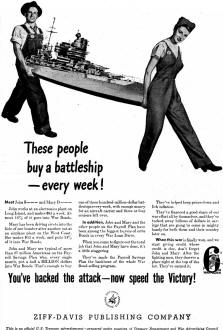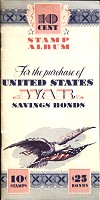|
 War Bonds were used by countries, including the United States,
Canada, Germany, and the United Kingdom, to help finance the expense of war without
causing massive inflation caused by printing more money. Particularly during war
times, governments were concerned with any amount of inflation since it would raise
the cost of procuring necessary materials. A meme popularized (by the government)
during World War II was, "Use it up. Wear it out. Make it do, or do without."
Similar to how modern day
Savings Bonds work, citizens bought the bonds at some fraction
of the face value (typically 1/2 or 3/4) with a maturity date of 10, 20, or more
years. On or after the maturity date, the bonds could/can be redeemed for the face
value plus and amount of interest which might have accumulated during the period.
I remember while in elementary school in the early--to-mid 1960s taking a dime to
class each week to buy a stamp for a $25 savings bond. Those bonds matured in the
mid 1980s and sat in a box until sometime in the early 2000s when I found them and
cashed them (3 or 4 Series E - not the newer EE - bonds) in for around $100
each. They stop accumulating interest after 30 or 40 years. War Bonds were used by countries, including the United States,
Canada, Germany, and the United Kingdom, to help finance the expense of war without
causing massive inflation caused by printing more money. Particularly during war
times, governments were concerned with any amount of inflation since it would raise
the cost of procuring necessary materials. A meme popularized (by the government)
during World War II was, "Use it up. Wear it out. Make it do, or do without."
Similar to how modern day
Savings Bonds work, citizens bought the bonds at some fraction
of the face value (typically 1/2 or 3/4) with a maturity date of 10, 20, or more
years. On or after the maturity date, the bonds could/can be redeemed for the face
value plus and amount of interest which might have accumulated during the period.
I remember while in elementary school in the early--to-mid 1960s taking a dime to
class each week to buy a stamp for a $25 savings bond. Those bonds matured in the
mid 1980s and sat in a box until sometime in the early 2000s when I found them and
cashed them (3 or 4 Series E - not the newer EE - bonds) in for around $100
each. They stop accumulating interest after 30 or 40 years.
U.S. Treasury War Bond Ad


U.S. War Bond Stamp Booklet
These people buy a battleship - every week!
Meet John S --- and Mary D ---
John works at an electronics plant on Long Island, and makes $85 a week. Almost
16% of it goes into War Bonds.
Mary has been driving rivets into the hide of one bomber after another out at
an airplane plant on the West Coast. She makes $55 a week, and puts 14% of it into
War Bonds.
John and Mary are typical of more than 27 million Americans on the Payroll Savings
Plan who, every single month, put a half a billion dollars into War Bonds. That's
enough to buy one of those hundred-million-dollar battleships every week, with enough
money for an aircraft carrier and three or four cruisers left over.
In addition, John and Mary and the other people on the Payroll Plan have been
among the biggest buyers of extra Bonds in every War Loan Drive.
When you come to figure out the total job that John and Mary have done, it's
a little staggering.
They've made the Payroll Savings Plan the backbone of the whole War Bond-selling
program. They've helped keep prices down and lick inflation.
They've financed a good share of our war effort all by themselves, and they've
tucked away billions of dollars in savings that are going to come in mighty handy
for both them and their country later on. When this war is finally won, and we start
giving credit where credit is due, don't forget John and Mary. After the fighting
men, they deserve a place right at the top of the list. They've earned it.
You've backed the attack - now speed the Victory!
Ziff-Davis Publishing company
This is an official U.S. Treasury advertisement - prepared under auspices of
Treasury Department and War Advertising Council
Posted December 23, 2019
|












